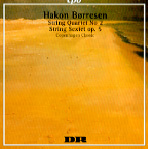Danish composer Hakon Borresen (1876-1954) never has reached the same level of (relative) popularity achieved by his countryman Carl Nielsen, and there is a reason for this. Infinitely more conservative and less personal in his inspiration, Borresen belongs to the hardcore turn-of-the-century followers of Brahms and other major exponents of the post-romantic era. The String Sextet (1901) might be largely influenced by Svendsen, as the liner notes suggest, but it sounds every bit like a post-scriptum to Dvorak’s chamber music output, with some Schubertian flavor spicing up the sauce here and there. Written almost 40 years later, the String Quartet No. 2 (1939) pursues the same quest for classical proportions and expressive chastity, despite the passionate profile of the first movement’s main theme and the noble sadness of the Andante patetico. No matter how well written and thoughtfully conceived these pieces are, they never really take off, probably because Borresen was more concerned with formal balance than intensity of expression. The performers do play with some fire, however, occasionally producing a forced, unpleasant sonority and a few intonation slips. The recorded sound slightly favors the low register.
































